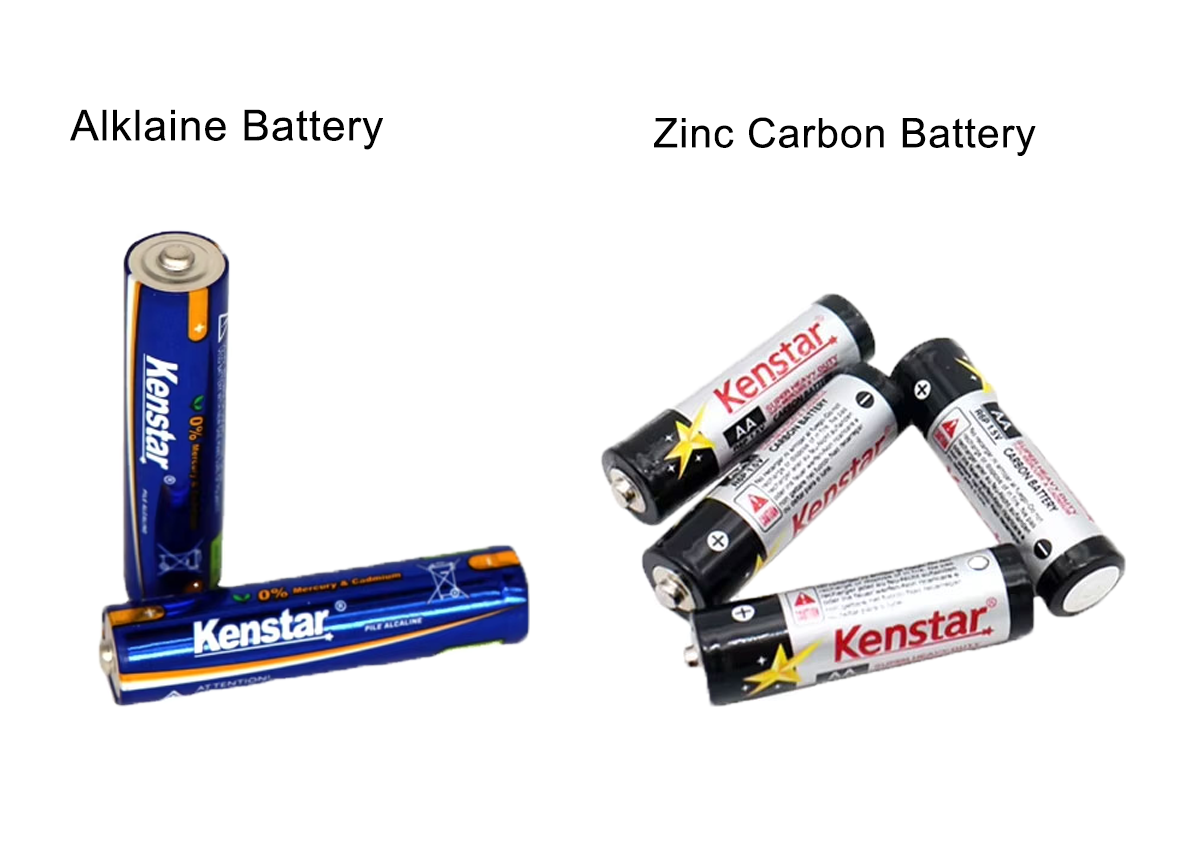Why Do Battery Types Matter for Everyday Use?
I rely on the Alkaline Battery for most household devices because it balances cost and performance. Lithium batteries provide unmatched lifespan and power, especially in demanding situations. Zinc carbon batteries suit low-power needs and budget constraints.
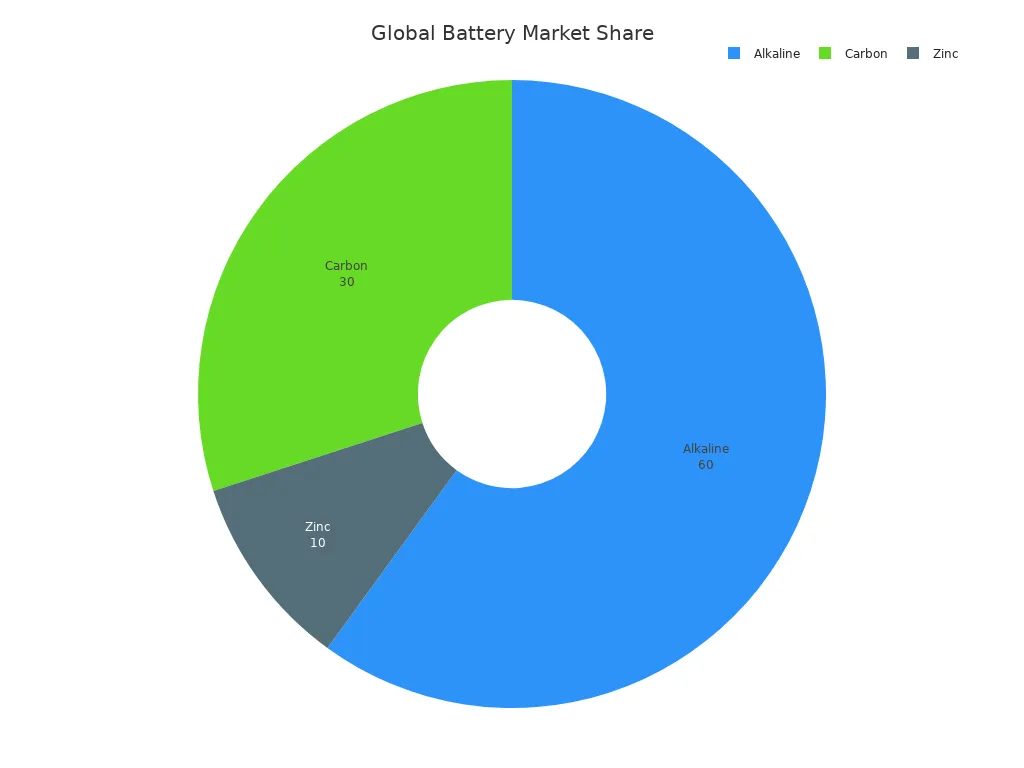
I recommend matching battery choice to device requirements for reliable results.
Key Takeaways
- Choose batteries based on your device’s power needs to get the best performance and value.
- Alkaline batteries work well for everyday devices, lithium batteries excel in high-drain or long-term use, and zinc carbon batteries suit low-drain, budget-friendly needs.
- Store and handle batteries safely by keeping them in cool, dry places away from metal objects and recycling them properly to protect the environment.
Quick Comparison Table

How Do Alkaline, Lithium, and Zinc Carbon Batteries Compare in Performance, Cost, and Lifespan?
I often compare batteries by looking at their voltage, energy density, lifespan, safety, and cost. The table below shows how alkaline, lithium, and zinc carbon batteries stack up against each other:
| Attribute | Carbon-Zinc Battery | Alkaline Battery | Lithium Battery |
|---|---|---|---|
| Voltage | 1.55V – 1.7V | 1.5V | 3.7V |
| Energy Density | 55 – 75 Wh/kg | 45 – 120 Wh/kg | 250 – 450 Wh/kg |
| Lifespan | ~18 months | ~3 years | ~10 years |
| Safety | Leaks electrolytes over time | Lower leakage risk | Safer than both |
| Cost | Cheapest upfront | Moderate | Highest upfront, cost-effective over time |
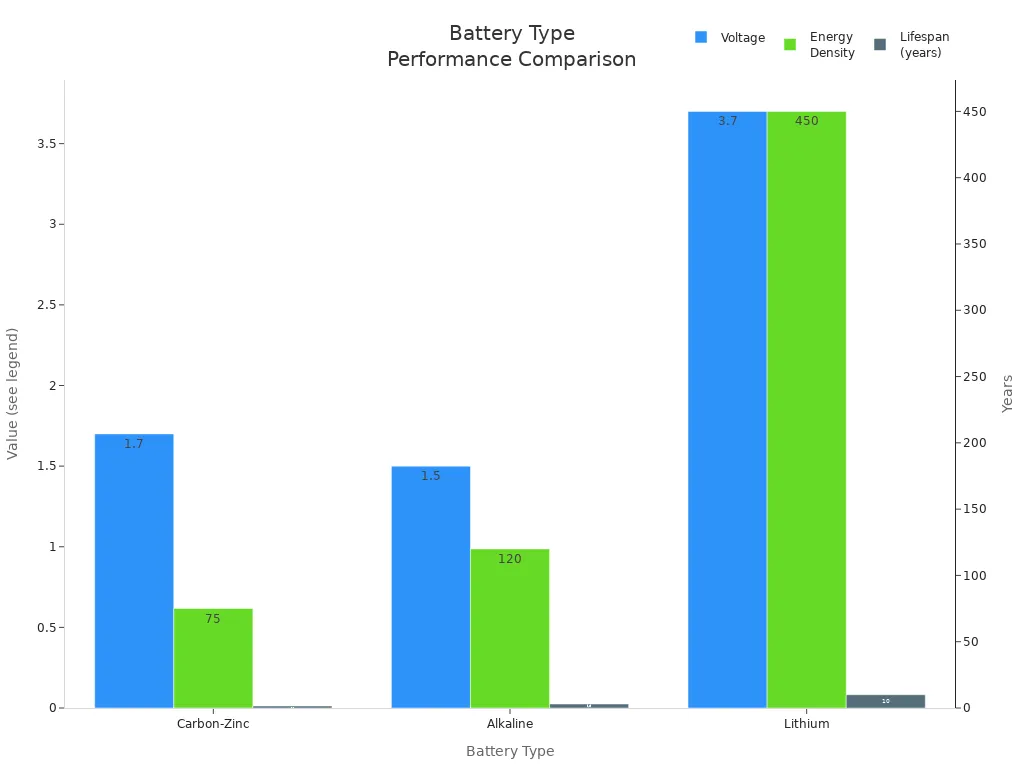
I see that lithium batteries deliver the highest energy density and lifespan, while alkaline batteries offer a solid balance for most uses. Zinc carbon batteries remain the most affordable but have a shorter lifespan.
Key Point:
Lithium batteries lead in performance and longevity, alkaline batteries balance cost and reliability, and zinc carbon batteries provide the lowest upfront cost.
Which Battery Type Fits Best for Different Devices?
When I choose batteries for specific devices, I match the battery type to the device’s power needs and usage pattern. Here’s how I break it down:
- Remote Controls: I use AAA alkaline batteries for their compact size and reliable performance in low-drain devices.
- Cameras: I prefer high-capacity alkaline AA batteries for consistent power, or lithium batteries for even longer use.
- Flashlights: I select super alkaline or lithium batteries to ensure long-lasting brightness, especially for high-drain models.
| Device Category | Recommended Battery Type | Reason/Notes |
|---|---|---|
| Remote Controls | AAA Alkaline batteries | Compact, reliable, ideal for low-drain |
| Cameras | Alkaline AA or Lithium batteries | High capacity, stable voltage, long-lasting |
| Flashlights | Super Alkaline or Lithium | High capacity, best for high-drain |
I always match the battery to the device’s needs to get the best performance and value.
Key Point:
Alkaline batteries work well for most everyday devices, while lithium batteries excel in high-drain or long-term applications. Zinc carbon batteries suit low-drain, budget-friendly uses.
Performance Breakdown
How Does the Alkaline Battery Perform in Everyday and Demanding Devices?
When I select a battery for daily use, I often reach for an Alkaline Battery. It delivers a steady voltage of about 1.5V, which works well for most household electronics. I notice that its energy density ranges from 45 to 120 Wh/kg, making it a reliable choice for both low and moderate-drain devices like remote controls, wall clocks, and portable radios.
In my experience, the Alkaline Battery stands out for its balance between capacity and cost. For example, an AA Alkaline Battery can provide up to 3,000 mAh in low-drain situations, but this drops to around 700 mAh under heavy loads, such as in digital cameras or handheld gaming devices. This means that while it performs well in most devices, its lifespan shortens in high-drain applications due to a noticeable voltage drop.
I also value the long shelf life of the Alkaline Battery. When stored properly, it can last between 5 and 10 years, which makes it ideal for emergency kits and devices that are used infrequently. Advanced technologies, like Power Preserve, help prevent leakage and maintain reliability over time.
| Battery Size | Load Condition | Typical Capacity (mAh) |
|---|---|---|
| AA | Low drain | ~3000 |
| AA | High load (1A) | ~700 |
Tip: I always store spare Alkaline Batteries in a cool, dry place to maximize their shelf life and performance.
Key Point:
The Alkaline Battery offers dependable power for most everyday devices, with strong performance in low to moderate-drain applications and a long shelf life for infrequent use.
Why Do Lithium Batteries Excel in High-Performance and Long-Term Use?
I turn to lithium batteries when I need maximum power and reliability. These batteries deliver a higher voltage, typically between 3 and 3.7V, and boast an impressive energy density of 250 to 450 Wh/kg. This high energy density means lithium batteries can power demanding devices like digital cameras, GPS units, and medical equipment for much longer periods.
One feature I appreciate is the stable voltage output throughout the discharge cycle. Even as the battery drains, lithium batteries maintain consistent performance, which is crucial for devices that require steady power. Their shelf life often exceeds 10 years, and they resist leakage and degradation, even in extreme temperatures.
Lithium batteries also support a high number of charge-discharge cycles, especially in rechargeable formats. For example, lithium-ion batteries used in consumer electronics typically last for 300 to 500 cycles, while lithium iron phosphate variants can exceed 3,000 cycles.
| Battery Type | Lifespan (Years) | Shelf Life (Years) | Performance Over Time Characteristics |
|---|---|---|---|
| Lithium | 10 to 15 | Often exceeds 10 | Maintains stable voltage, resists leakage, performs well under extreme temperatures |
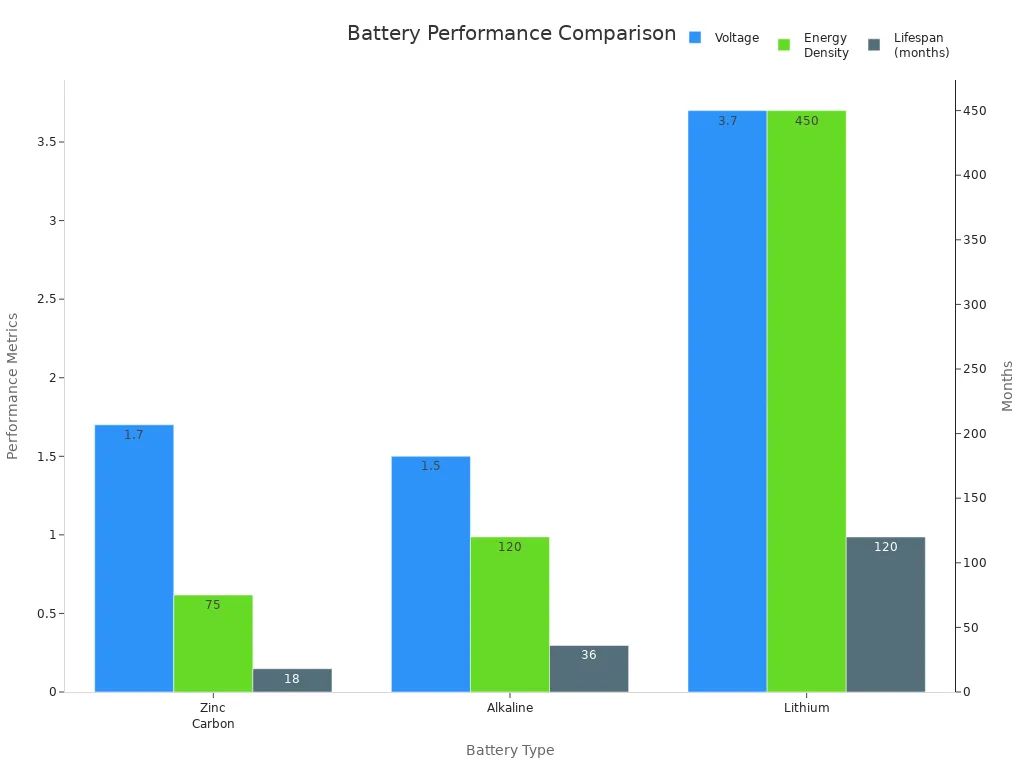
Note: I rely on lithium batteries for high-drain devices and critical applications where performance and longevity matter most.
Key Point:
Lithium batteries deliver superior energy density, stable voltage, and long shelf life, making them the best choice for high-drain and long-term use devices.
What Makes Zinc Carbon Batteries Suitable for Low-Drain and Occasional Use?
When I need a budget-friendly option for simple devices, I often choose zinc carbon batteries. These batteries provide a nominal voltage of about 1.5V and have an energy density between 55 and 75 Wh/kg. While not as powerful as other types, they work well in low-drain, intermittent-use devices like wall clocks, basic flashlights, and remote controls.
Zinc carbon batteries have a shorter lifespan, usually around 18 months, and a higher risk of leakage over time. Their self-discharge rate is about 0.32% per month, which means they lose charge faster during storage compared to other types. They also experience significant voltage drops under load, so I avoid using them in high-drain devices.
| Feature | Zinc Carbon Battery | Alkaline Battery |
|---|---|---|
| Energy Density | Lower energy density, suitable for low-drain use | Higher energy density, better for continuous or high-drain use |
| Voltage | 1.5V | 1.5V |
| Shelf Life | Short (1-2 years) | Long (5-7 years) |
| Cost | Less expensive | More expensive |
| Suitable For | Low-drain, intermittent-use devices (e.g., clocks, remote controls, simple flashlights) | High-drain, continuous use devices |
| Leakage Risk | Higher risk of leakage | Lower risk of leakage |
Tip: I use zinc carbon batteries for devices that do not require continuous power and where cost savings are a priority.
Key Point:
Zinc carbon batteries are best for low-drain, occasional-use devices where affordability is more important than long-term performance.
Cost Analysis
How Do Upfront Costs Differ Between Alkaline, Lithium, and Zinc Carbon Batteries?
When I shop for batteries, I always notice that the upfront price varies significantly by type. Alkaline batteries usually cost more than zinc carbon batteries, but less than lithium batteries. Lithium batteries command the highest price per unit, reflecting their advanced technology and longer lifespan.
Bulk purchasing can make a big difference. I often see that buying in larger quantities reduces the per-unit price, especially for popular brands. For example, Duracell Procell AA batteries can drop to $0.75 per unit, and Energizer Industrial AA batteries can go as low as $0.60 per unit when bought in bulk. Zinc carbon batteries, such as Eveready Super Heavy Duty, start at $2.39 per unit for small quantities but decrease to $1.59 per unit for larger orders. Panasonic Heavy Duty batteries also offer discounts, though the exact percentage varies.
| Battery Type & Brand | Price (per unit) | Bulk Discount % | Bulk Price Range (per unit) |
|---|---|---|---|
| Duracell Procell AA (Alkaline) | $0.75 | Up to 25% | N/A |
| Energizer Industrial AA (Alkaline) | $0.60 | Up to 41% | N/A |
| Eveready Super Heavy Duty AA (Zinc Carbon) | N/A | N/A | $2.39 → $1.59 |
| Panasonic Heavy Duty AA (Zinc Carbon) | N/A | N/A | $2.49 (base price) |
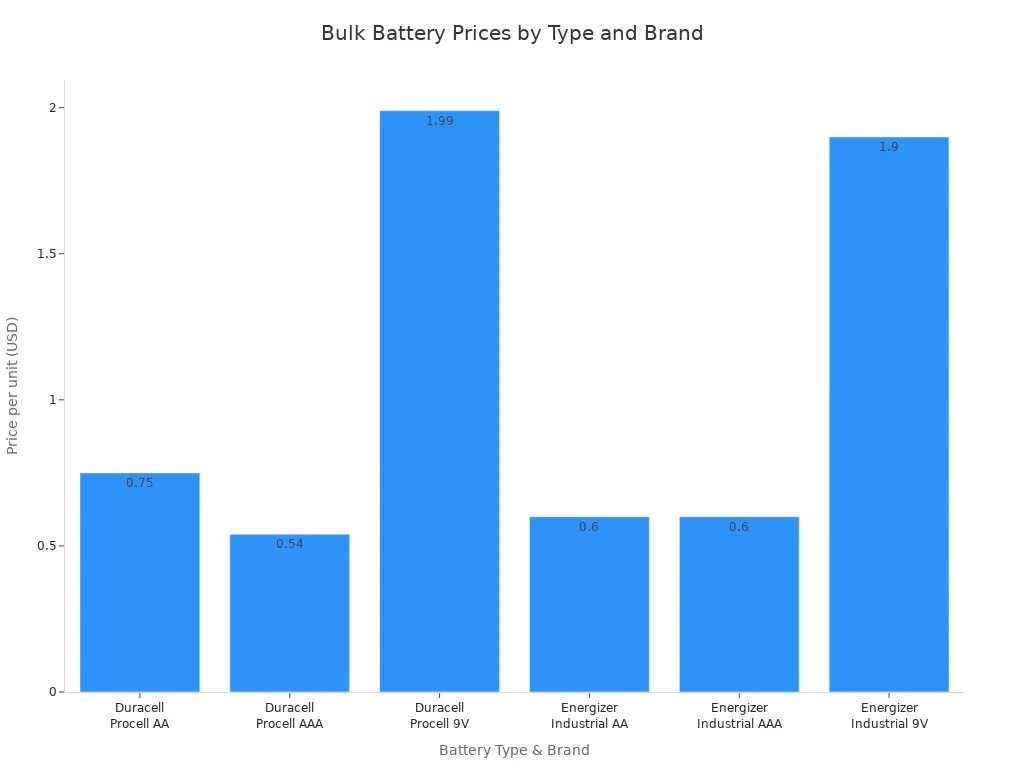
I always recommend checking for bulk discounts and free shipping offers, as these can lower the total cost, especially for businesses or families who use batteries frequently.
Key Point:
Alkaline batteries offer a strong balance between price and performance, especially when purchased in bulk. Zinc carbon batteries remain the most affordable for small, occasional needs. Lithium batteries cost more upfront but deliver advanced features.
What Is the True Long-Term Value and How Often Will I Need to Replace Each Battery Type?
When I consider the total cost of ownership, I look beyond the sticker price. I factor in how long each battery lasts and how often I need to replace it. Alkaline batteries provide a moderate lifespan, so I replace them less often than zinc carbon batteries. Lithium batteries last the longest, which means fewer replacements over time.
For devices that run continuously or require high power, I find that lithium batteries offer the best long-term value. Their higher upfront cost pays off because I do not need to change them as frequently. In contrast, zinc carbon batteries require more frequent replacement, which can add up in the long run, even though they cost less per unit.
Here is how I compare replacement frequency and long-term value:
- Alkaline Batteries:
I use these for most household devices. They last longer than zinc carbon batteries, so I buy replacements less often. This saves me time and reduces waste.
- Lithium Batteries:
I choose these for high-drain or critical devices. Their long lifespan means I rarely need to replace them, which offsets the higher initial investment.
- Zinc Carbon Batteries:
I reserve these for low-drain, occasional-use devices. I replace them more often, so the total cost can rise if I use them in devices that run frequently.
I always calculate the total cost over a year or the expected life of the device. This helps me choose the battery that delivers the best value for my needs.
Key Point:
Lithium batteries provide the best long-term value for high-use or critical devices due to their longevity. Alkaline batteries strike a balance between cost and replacement frequency for everyday use. Zinc carbon batteries suit short-term or infrequent needs but may require more frequent replacement.
Best-Use Scenarios
Which Battery Type Works Best for Everyday Devices?
When I select batteries for household items, I focus on reliability and cost. Most consumer usage surveys show that the Alkaline Battery dominates in everyday devices. I see this trend in clocks, remote controls, toys, and portable radios. These devices require steady power but do not drain batteries quickly. The AA and AAA sizes fit most products, and their long shelf life means I do not worry about frequent replacements.
- Alkaline batteries generate nearly 65% of primary battery market revenues.
- They offer versatility, cost-effectiveness, and compatibility with a wide range of low-drain electronics.
- Remote controls and toys represent a significant portion of alkaline battery demand.
| Battery Type | Performance Outcome | Ideal Device Usage | Additional Notes |
|---|---|---|---|
| Alkaline | Reliable, long shelf life | Toys, clocks, remote controls | Affordable, widely available |
| Zinc-Carbon | Basic, lower energy | Simple devices | Prone to leakage, older tech |
| Lithium | High performance | Rare in low-drain devices | Higher cost, longer shelf life |
Key Point: I recommend the Alkaline Battery for most household devices due to its balance of cost, performance, and availability.
Which Battery Type Should I Use for High-Drain Devices?
When I power digital cameras or portable gaming systems, I need batteries that deliver consistent energy. Industry experts recommend lithium-based batteries for these high-drain devices. Lithium batteries provide higher energy density and longer life compared to alkaline batteries. I trust brands like Duracell and Sony for their reliable lithium-ion options. Rechargeable NiMH batteries also perform well in gaming controllers.
- Lithium batteries excel in digital cameras and handheld gaming consoles.
- They offer stable voltage, longer runtime, and resist leakage.
- Alkaline batteries work for moderate loads but drain quickly in high-drain devices.
| Device Power Consumption | Example Devices | Typical Battery Life in Alkaline Batteries |
|---|---|---|
| High-Drain | Digital cameras, gaming consoles | Hours to several weeks |
Key Point: I choose lithium batteries for high-drain devices because they deliver superior performance and extended lifespan.
Which Battery Type Is Best for Occasional-Use and Emergency Devices?
For emergency kits and devices I use infrequently, I prioritize shelf life and reliability. Preparedness organizations suggest power banks and low self-discharge NiMH batteries for backup. Non-rechargeable batteries with low self-discharge rates, such as primary lithium or modern NiMH, retain charge for years. I rely on these for smoke detectors, emergency flashlights, and backup systems.
- Low self-discharge batteries require less frequent recharging and maintain charge longer.
- Non-rechargeable batteries suit infrequent use due to minimal self-discharge.
- Rechargeable NiMH batteries with low self-discharge technology, like Eneloop, offer readiness after storage.
Key Point: I recommend low self-discharge batteries or primary lithium for emergency and occasional-use devices to ensure reliability when needed.
Safety and Environmental Considerations
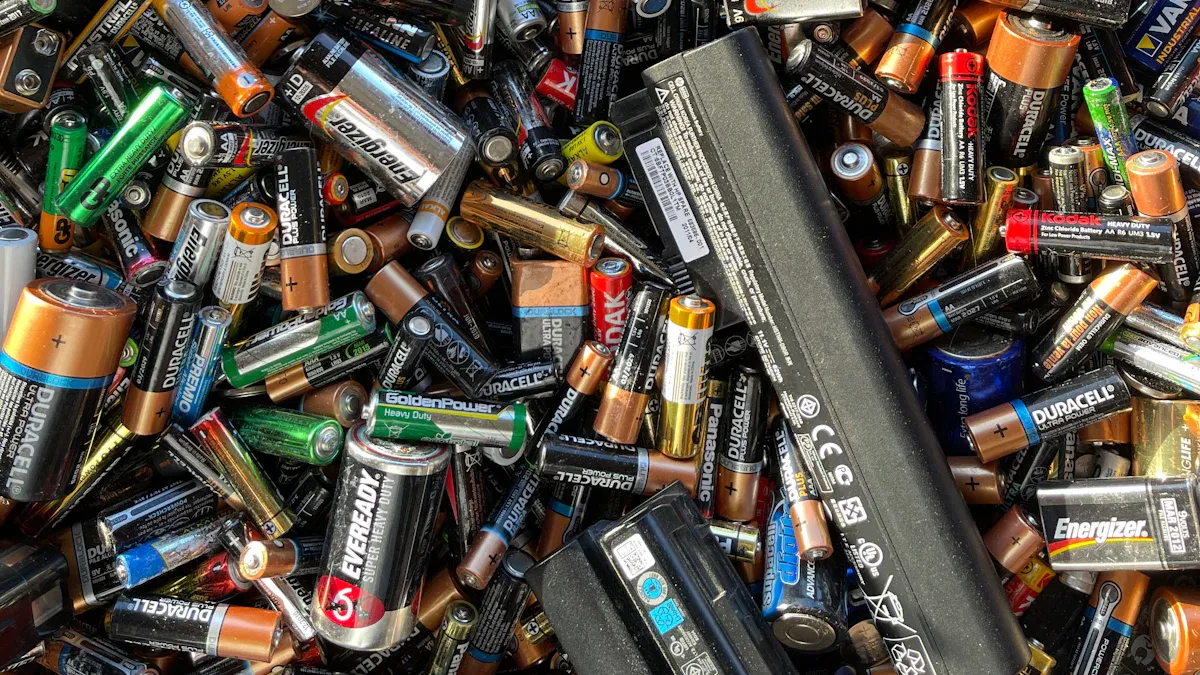
How Can I Ensure Safe Use and Storage of Batteries?
When I handle batteries, I always prioritize safety. Different battery types present unique risks. Here’s a quick overview of common incidents:
| Battery Type | Common Safety Incidents | Key Hazards and Notes |
|---|---|---|
| Alkaline | Heating from short circuits with metal objects | Low ignition risk; possible corrosive leakage; hydrogen gas if recharged improperly |
| Lithium | Overheating, fires, explosions, burns from short circuits or damage | High temperatures possible; ingestion hazard with coin cells |
| Zinc Carbon | Similar to alkaline if mishandled or opened | Ingestion hazard with button/coin cells |
| Button/Coin Cells | Ingestion by children causing burns and tissue damage | Nearly 3,000 children treated annually for ingestion injuries |
To minimize risks, I follow these best practices:
- I store batteries in cool, dry places, ideally between 68-77°F.
- I keep batteries away from metal objects and use non-conductive containers.
- I separate damaged or leaking batteries immediately.
- I regularly inspect for corrosion or leaks.
Tip: I never mix battery types in storage and always keep them out of reach of children.
Key Point:
Proper storage and handling reduce safety risks and extend battery life.
What Should I Know About Battery Environmental Impact and Disposal?
I recognize that batteries impact the environment at every stage. Manufacturing alkaline and zinc carbon batteries requires mining metals like zinc and manganese, which damages ecosystems and uses significant energy. Lithium batteries need rare metals such as lithium and cobalt, leading to habitat loss and water scarcity. Improper disposal can pollute soil and water, with a single battery contaminating up to 167,000 liters of drinking water.
- Alkaline batteries are single-use and contribute to landfill waste.
- Recycling rates remain low due to complex processes.
- Zinc carbon batteries, especially in markets like India, often end up in landfills, causing heavy metal leakage.
- Lithium batteries, if not recycled, pose hazardous waste risks.
Many countries enforce strict recycling regulations. For example, Germany requires manufacturers to take back batteries for recycling. The US has laws restricting hazardous batteries and streamlining collection. Europe maintains collection rates between 32-54% for portable batteries.
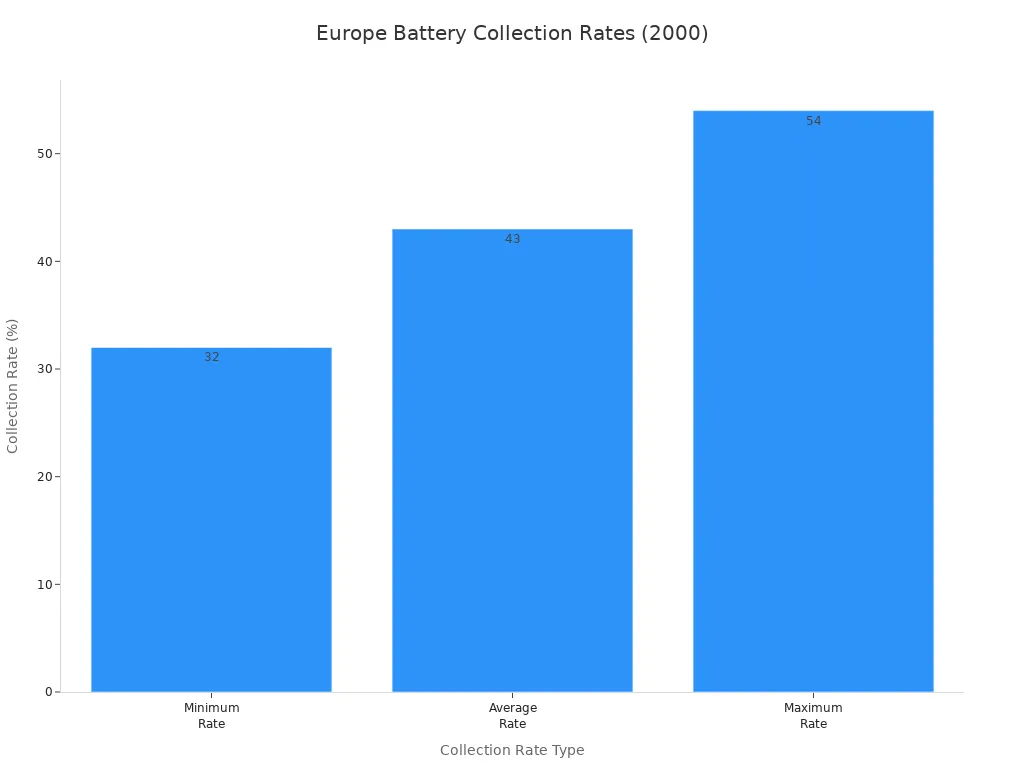
Note: I always use designated recycling programs to dispose of used batteries responsibly.
Key Point:
Responsible disposal and recycling help protect the environment and reduce health risks from battery waste.
Which Battery Type Should I Choose for My Device?
| Factor | Alkaline Battery | Zinc Carbon Battery | Lithium Battery |
|---|---|---|---|
| Energy Density | Moderate to high | Low | Highest |
| Longevity | Several years | Shorter lifespan | 10+ years |
| Cost | Moderate | Low | High |
I select Alkaline Battery for most household devices. Lithium batteries power high-drain or critical equipment. Zinc carbon batteries fit budget or short-term needs. Matching battery type to device ensures optimal performance and cost-effectiveness.
What Are the Key Points to Remember?
- Check device compatibility and energy needs.
- Consider battery longevity and environmental impact.
- Balance cost with performance for the best results.
FAQ
How do I know which battery type my device needs?
I check the device manual or battery compartment label. Manufacturers usually specify the recommended battery type for optimal performance.
Key Point: Always follow device guidelines for best results.
Can I mix different battery types in one device?
I never mix battery types. Mixing can cause leakage or reduced performance. I always use the same type and brand for safety.
Key Point: Use identical batteries to prevent damage.
What is the safest way to store unused batteries?
I store batteries in a cool, dry place away from metal objects. I keep them in their original packaging until use.
Key Point: Proper storage extends battery life and ensures safety.
Post time: Aug-13-2025

